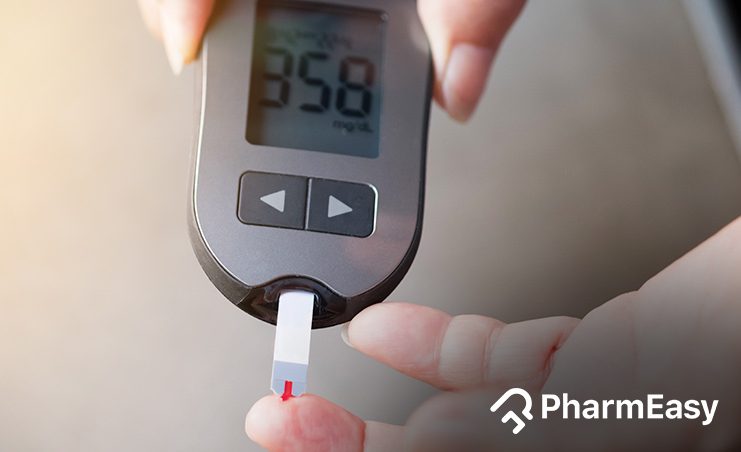Everything About Blood Sugar Levels and Ranges You Must Know
By Dr. Nikita Toshi +2 more

Get,

to manage your symptom
Get your,


4 Cr+ families
benefitted

OTP sent to 9988776655



You’ve successfully subscribed to receive
doctor-approved tips on
Whatsapp

Get ready to feel your best.

Hi There,
Download the PharmEasy App now!!


Register to Avail the Offer
Send OTPBy continuing, you agree with our Privacy Policy and Terms and Conditions

Hi There,
Sign up on PharmEasy now!!
Trusted by 4 crore+ families

OTP sent to 9988776655



You have unlocked 25% off on medicines




Code: NU25
By Dr. Nikita Toshi +2 more
Table of Contents
Key pillars of diabetes management include taking prescribed medications on time, monitoring and recording your blood sugar levels as advised and making necessary diet and lifestyle changes. There are different tests to measure blood sugar levels and each has different reference ranges. High blood sugar levels are known as hyperglycemia, while low blood sugar levels are called hypoglycemia.
For a person with diabetes, it’s exceedingly vital to check blood sugar levels every now and then. Read on to know the normal blood sugar levels in the human body.

For individuals with diabetes, the normal blood glucose range before eating should be 80-100 mg/dL. After 2 hours of eating a meal, the blood sugar level range should be less than 140 mg/dL.
A reading of over 180 mg/dL after two hours comes under the high blood sugar level range. On the other hand, a blood sugar level under 70 mg/dL is low.
High blood sugar or hyperglycemia is a presentation of diabetes. A doctor will evaluate your blood sugar levels at different times to make a diagnosis. Very high blood sugar can make a person feel unwell and may present with the following symptoms –
Here are a few ways of preventing high blood sugar:
Follow the medications prescribed by your doctor.
In case of blood sugar levels higher than 260 mg/dL, talk to your doctor for adjustment in the ongoing treatment regimen if needed.
Work on your diet and exercise plan.
Also known as hypoglycemia, blood sugar levels can go down when a diabetic person doesn’t consume sufficient food. Read on to learn some of the other symptoms of low blood sugar.
You may show any of these symptoms if your blood sugar drops suddenly. In many cases, people also suffer from low blood sugar even though their levels are higher.
For instance, if the blood sugar level was 300 mg/dL for a week and suddenly lowered to 100 mg/dL, it can also be a symptom of low blood sugar.
Here are some of the ways to prevent low blood sugar problems.
Fast-acting carbohydrates such as juices, glucose tablets and regular soda are effective ways of controlling low blood sugar. If an individual cannot consume food or drinks, make sugar paste and give it to him/her.
By recognising the sugar level increase symptoms mentioned above, diabetes patients can avoid medical emergencies like diabetic ketoacidosis. The sooner an individual understands these symptoms, the sooner they can test and avoid critical situations.
A potent way of managing your diabetes is to keep a clear target range. Monitoring blood sugar levels can help eliminate long-term diabetes complications.
While such foods are free from sugar, they still contain a lot of carbohydrates. It is essential to check the nutritional facts before digging into sugar-free foods. For instance, a dessert or ice cream labelled sugar-free will still have lots of calories and carbohydrates.
The goal of sports drinks is to replenish your energy levels quickly. That said, plenty of it contains as much sugar as soda. So they can increase your blood sugar levels.
Many types of yoghurts have healthy bacteria. They help enhance digestion and facilitate the balancing of blood sugar levels. However, some contain added sugars and flavours that can affect your normal blood glucose level.
While fruits are healthy, dried fruits contain a lot of carbohydrates in a small pack. For instance, three dates have 15 grams of carbs. That is why they can cause an upswing in your blood sugar levels.
While high blood sugar and low blood sugar are severe conditions, they can be controlled by constant glucose monitoring and avoiding certain habits. To make sure that your average blood sugar level is maintained, you must keep a record of it all. It’d allow your doctor to modify the treatment, for instance, the amount of insulin to take, as and when needed. Plus, you’d be able to take the right actions to control your diabetes by monitoring glucose.
Disclaimer: The information provided here is for educational/awareness purposes only and is not intended to be a substitute for medical treatment by a healthcare professional and should not be relied upon to diagnose or treat any medical condition. The reader should consult a registered medical practitioner to determine the appropriateness of the information and before consuming any medication. PharmEasy does not provide any guarantee or warranty (express or implied) regarding the accuracy, adequacy, completeness, legality, reliability or usefulness of the information; and disclaims any liability arising thereof.
Links and product recommendations in the information provided here are advertisements of third-party products available on the website. PharmEasy does not make any representation on the accuracy or suitability of such products/services. Advertisements do not influence the editorial decisions or content. The information in this blog is subject to change without notice. The authors and administrators reserve the right to modify, add, or remove content without notification. It is your responsibility to review this disclaimer regularly for any changes.

Leave your comment...
Comments